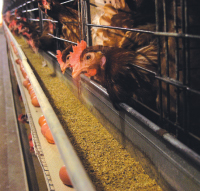
By Tim Nelson, Executive Director and Kimberly Sheppard, Research
Co-ordinator
Effect on the bone density and egg quality of brown and white table egg layers
As laying hens age, both egg quality and bone density decrease. Decreased egg quality translates to economic losses for egg producers. Decreased bone density (osteoporosis) is a welfare concern for a couple of reasons.
Osteoporosis can hamper a bird’s ability to reach food and water and secondly, weakened bones can break easily both during production and depopulation. This is painful and also results in a loss in egg production if it occurs during lay. Some birds are more prone to osteoporosis than others, therefore if producers are experiencing a problem with osteoporosis in their flocks, it is important that they have management strategies to help control this problem.
FEATURED RESEARCHER – DOUG KORVER

Doug Korver, together with Crystal Riczu and Kerry Nadeau at the University of Alberta, has been studying possible ways to make the bones of older hens stronger. One of the reasons bones become weak in laying hens is that some of the calcium being used to make eggshell comes from the bone. This happens when the digestive tract is empty and there is therefore no calcium in the gut to use in eggshell production.
Most of the feed that hens consume before the lights go out is digested before the lights come on in the morning, and since shell calcification takes approximately 20 hours, much of the process is occurring at night when there is no dietary calcium left in the digestive tract.
Korver and his team investigated whether allowing an hour-long midnight feeding could increase the amount of calcium coming directly from the digestive tract for eggshell formation, for both white and brown layers.
 |
| PREVENTING OSTEOPOROSIS Dr. Doug Korver examined whether providing an hour-long midnight feeding could increase the amount of dietary calcium available for birds, preventing calcium uptake from bones. |
Their findings? Overall, midnight feeding did not improve the skeletal health of the birds, egg production, or egg shell quality. The researchers
say it is important to note, however, that the birds used in the study may not have been prone to osteoporosis and therefore showed no benefit from the midnight feeding. They suggest that in the instance of osteoporosis developing in a flock, midnight feeding may still be beneficial. To read more about this project, visit: www.poultryindustrycouncil.ca and click on “Research Results.”
Doug Korver was born and raised in Lethbridge, Alberta., Canada. He graduated from the University of Saskatchewan in 1990 with a Bachelor of Science in Agriculture, and began a Master’s degree program at the University of Delaware. During his time there, he investigated to role of dietary fat stability on feed quality and broiler chicken performance. He completed the M.Sc. degree in 1993 and began his Doctoral program at the University of California, Davis. His research at Davis focused on the interaction of nutrition and inflammation, as modulated by omega-3 fatty acids. His PhD was conferred 1997.
Doug returned to the University of Saskatchewan to take up a Post-doctoral Research Fellowship, working with Dr. Hank Classen.
In May of 1997, Doug began his appointment as Assistant Professor of Poultry Nutrition at the University of Alberta. Relevance of his research to the poultry industry remains a hallmark of his approach to research. Recently, in collaboration with other researchers at the University of Alberta, he has developed and is using the Indicator Amino Acid Oxidation method for the determination of amino acid requirements of poultry to assess changes in protein synthesis during the inflammatory response in broiler chickens.
Doug’s interest in avian bone metabolism has led his research group to validate the use of Quantitative Computed Tomography to measure distribution of bone mineral among various bone types in poultry. This method allows bone mineralization in individual birds to be followed through the various stages of production.
Doug is active in teaching, and has won several individual departmental, faculty and university teaching awards. As a member of the Alberta Poultry Research Centre he also shared in the 2004 World’s Poultry Science Association Education Award. In 2008, he was awarded the Poultry Science Association’s “American Feed Industry Association Nutrition Research Award”.
Doug is the author or co-author of 30 peer-reviewed papers, six book chapters, and 52 abstracts at scientific conferences. He has presented over 60 invited talks in North and South America, Europe and Asia at scientific and poultry industry technical conferences.
Role of altered hemostasis in FLHS Drs. Darren Wood and Jim Squires, University of Guelph Fatty Liver Hemmorhagic Syndrome (FLHS) can affect up to five per cent of hens at peak of lay and is therefore of economic significance to producers. Livers from hens that die from this disease have excessive fat accumulation and signs of internal bleeding in multiple areas. Preliminary evidence suggests that there is a difference in the rate of blood clot formation in plasma from FLHS-susceptible hens compared to plasma from normal hens. Drs. Darren Wood and Jim Squires and their research team at the University of Guelph thought that if they could discover the cause of blood clotting abnormalities in laying hens with FLHS, then not only might it provide the industry with a way forward in managing this important disease, but it might also provide a model to study the impact of abnormal blood coagulation in other diseases where blood clotting abnormalities have also been observed. In this study the researchers fed three different diets: standard, higher fat and omega-3 to an inbred strain of hens predisposed to FLHS, and to an age-matched single-comb white leghorn (SCWL) flock. Fat enriched diets were fed because they have previously been shown to induce the FLHS syndrome. The researchers investigated which factors regulate thrombin, generation in plasma from the normal and FLHS-susceptible laying hens. Thrombrin is the protein responsible for blood coagulation. The method also allowed them to look at whether changes in blood parameters of FLHS-susceptible laying hens are representative of the situation in normal laying hens that spontaneously develop FLHS. Their findings? It was found that the strain of laying hens susceptible to FLHS did exhibit a higher frequency of FLHS than the SCWL hens. The FLHS susceptible birds also exhibited a slightly higher clotting activity. However, despite this and regardless of strain or diet, the higher frequency of the syndrome observed in the FLHS susceptible hens did not appear to be related to abnormalities in the hemostatic (blood clotting) system. This suggests that coagulation abnormalities do not appear to be the reason for hemorrhage associated with FLHS. Some differences in fatty acid (lipid) profiles possibly associated with the strains and diets were observed and this observation has led to a further investigation. The thinking behind this being that these lipid variations may cause cell membrane abnormalities, which could occur in the liver or thrombocytes and contribute to the development of the syndrome. To read more about this project, visit www.poultryindustrycouncil.ca and click on “Research Results.” |
FEATURED RESEARCHER – DARREN WOOD
Darren Wood has been a faculty member in the department of Pathobiology since 2002. He graduated with a Doctor of Veterinary Medicine in 1994 from
the Atlantic Veterinary College, and completed graduate training and board certification in veterinary clinical pathology in 2001. He has a special interest in the diagnosis and pathogenesis of coagulation disorders in multiple species.
PIC PICKS
Research Day
This year’s research day was definitely a winner. “I’ve been coming to research day for years – this was the best in a long time, really practical,” said Brian Baynton, Alltech.
Focusing on research that’s delivering what the market is looking for and overcoming production issues, this year’s research day really drilled down to our industry’s core business with some eye- opening research and insight into how we can meet emerging market trends for nutritionally superior poultry products by manipulating production and some of the management issues that this might reveal.
For a full report, see our website .
Annual Meeting
What, already? Please make a date change in your diaries. The PIC Annual Meeting will be held in conjunction with an industry meeting on Oct. 7, venue to be confirmed.
Golf Tournament
It sounds like advertising, but it’s true! By the time you receive this, the PIC golf tourney, scheduled for Sept. 10, will be well on the way to being sold out! Register now at www.poultryindustrycouncil.ca .
Research Resources
What do we need? Where should they be located?
Have your say on the web at http://poultryresearch.blogspot.com/ . If you haven’t got web access but would like to hear what others are saying and join in the discussion by posting a comment through PIC, simply give us a call at 519-837-0284.
Print this page